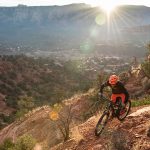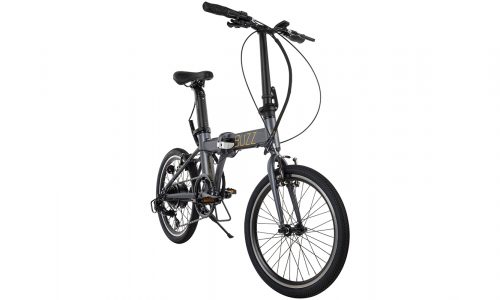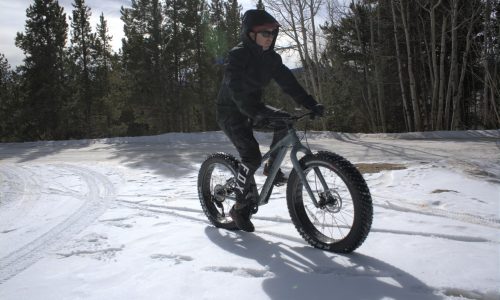Home » Gear Reviews » Biking » Road Bikes » Fuji SL 1.3
Fuji SL 1.3 Review
November 30, 2016





















 89
89 The Good
- Lightest in group
- Stiff enough for sprinting
- Excellent value for Dura Ace Di2
- Tubeless-ready rims
The Bad
- Some instability on descents
- Could use a wheel upgrade
- Some front-end flex under load
The lightest bike in our group, and one of the lightest Road Race bikes on the market, and featuring the sublime Dura Ace Di2 drivetrain—all for around $6200—the Fuji SL 1.3 is an incredible value for a high-end racing machine. Its 14lb weight and surprisingly stiff bottom bracket area make this a ridiculously good climber, but it can also hang on the rollers and flats, although it’s somewhat less solid on descents. If you’re a pure climber, but don’t want a total noodle under you during sprinting or sustained efforts, this is an excellent choice and a major bargain.
Ride Quality
The Fuji SL 1.3 has impressive stiffness relative to its ultralight weight, but that doesn’t compromise its ride quality. Super thin seatstays and a narrow seat post allow for excellent compliance, although under heavy load we noticed some bounce in the post, which sacrifices some efficiency. And the position is not overly aggressive relative to many Road Race bikes, allowing for more comfort on longer rides—and especially on long climbs the position offered an ideal compromise for power and comfort.
Stiffness-to-Weight/Power Transfer
Many ultralight bikes like the Fuji SL 1.3 suffer from major flex in the frame, limiting efficiency, but the Fuji remains fairly stiff despite its 14lbs. While we could certainly feel some give underfoot and in the front end during explosive efforts, especially out of the saddle, the power transfer was acceptable for most riding other than pure sprints. This is definitely not a sprinter’s or breakaway specialist’s best choice, but most riders looking for an ultralight machine like this prefer climbing anyway, and for that the Fuji excels.
Climbing/Efficiency
This is what the Fuji SL 1.3 is made for. With a comfortable position, relative to other Race bikes, a surprising stiff bottom and rear, and ultralight wheels, this is a climber’s dream bike, especially considering the budget price. Seated climbing seems absolutely effortless, and the longer you go the more the benefit of the light weight. Even standing efforts were acceptable for most riders, although over the steepest sections there was some noticeable flex underfoot and especially in the front end. If short, very steep, power climbs are your thing, this may not be the best option—but for most climbers, this is an outstanding option and value.
Descending/Handling
What goes up must come down, and while the Fuji SL 1.3 goes up really fast, coming down is not quite its forte—at this weight it’s very difficult to build a bike that can handle the incredible torques of fast descending, especially in the front end. The Fuji is by no means a bad descender—on the contrary it’s relatively solid for a pure climber—but once it gets up to over 30 mph and especially 40 there is noticeable wobble if the road is rough or undulating. Fortunately we generally didn’t feel it on smooth roads. As for handling, you can throw this feather-of-a-bike around a bit, usually with solid results, but it was less stable in super tight turns and/or at higher speeds.
Components, Drivetrain, Shifting and Brakes
Whether or not you like electronic shifting—many riders simply prefer the feel of a mechanical shift, and don’t want to worry about battery or other issues—no one can deny the incredible precision, speed and reliability of Shimano’s Dura Ace Di2 system. The Fuji SL 1.3 features this setup at a shockingly low price, considering the cost of this group. Shifting is simply effortless, and there’s a wide range of gearing with the sub-compact 52/36T front rings and 11-25 cassette, although on a pure climber like this a 28 would be more appropriate. Adjustments are super simple, with a few clicks of the lever moving the derailleurs ever-so-slightly one way or the other. Our major complaint about DA Di2 is the considerably higher cost, which we don’t feel is worth the minor weight savings over Ultegra Di2 and/or the mechanical versions, but for those who must have electronic, this is as good as it gets, especially at what Fuji is charging.
The drivetrain is complemented by a solid collection of Oval carbon post, bars and saddle rails, and alloy stem. The contoured bars and top-end saddle were quite comfortable and ergonomic.
Wheelset
The Fuji SL 1.3 features Oval’s 724 alloy wheelset, which while not a super high-end set offers an excellent combination of light weight and all-around performance. Climbers will love the ultralight sub-1300g weight, and the 24mm depth is just enough to add minor aero savings. They’re even stiff enough to stand up and sprint on, although under heavy power there is some flex. Unfortunately the 22mm width is narrow for today’s wider tires, resulting in less-than-ideal performance in cornering and overall traction.
Scott Boulbol
- FacultyBoulbol wrote the book on trail running in Colorado.Scott Boulbol is a freelance writer who has been working in the outdoor and cycling industries for about 15 years. He lives near Boston.


















